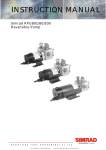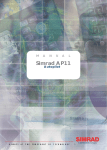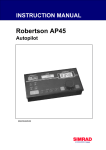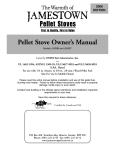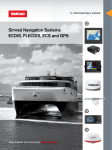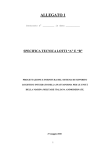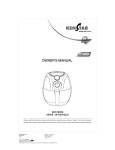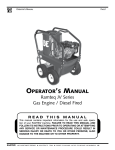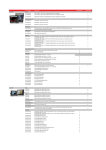Download Simrad Axis 200 Instruction manual
Transcript
INSTRUCTION MANUAL Simrad RPU80/160/300 Reversible Pump Note! Simrad AS makes every effort to ensure that the information contained within this document is correct. However, our equipment is continuously being improved and updated, so we cannot assume liability for any errors which may occur. Warning! The equipment to which this manual applies must only be used for the purpose for which it was designed. Improper use or maintenance may cause damage to the equipment or injury to personnel. The user must be familiar with the contents of the appropriate manuals before attempting to operate or work on the equipment. Simrad AS disclaims any responsibility for damage or injury caused by improper installation, use or maintenance of the equipment. Copyright © 2004 Simrad AS The information contained within this document remains the sole property of Simrad AS. No part of this document may be copied or reproduced in any form or by any means, and the information contained within is not to be communicated to a third party, without the prior written consent of Simrad AS. Instruction Manual Instruction Manual This manual is intended as a reference guide for correctly installing and maintaining the RPU80, RPU160 and RPU300 reversible pumps. Please take time to read this manual to get a thorough understanding of the reversible pump and its relationship to a complete autopilot system. Other documentation material that is provided with your system includes a warranty card. This must be filled out by the authorized dealer that performed the installation and mailed in to activate the warranty. 20220422N 1 Simrad Reversible Pump RPU80/160/300 Document revisions Rev Documentation department Date Sign Hardware/Software design Date Sign Project/Product Management Date Sign D 24/10-96 N.G. 24/10-96 I.K. 24/10-96 Th.H. E 20/2-97 N.G. 20/2-97 I.K. 20/2-97 Th.H. F 5/1-98 N.G. 5/1-98 I.K. 5/1-98 Th.H. G 20/1-99 N.G. 20/1-99 I.K. 20/1-99 Th.H. H 21/1-00 N.G. 21/1-00 I.K. 21/1-00 Th.H. I 17/10-00 N.G. 17/10-00 I.K. 17/10-00 Th.H. J 30.08.01 N.G. 30.08.01 I.K. 30.08.01 Th.H. K 22.03.02 N.G. 22.03.02 I.K. L 15.01.03 N.G. 15.01.03 I.K. 16.01.03 Th.H. M 28.04.03 N.G. 28.04.03 I.K. 28.04.03 Th.H. N 11.03.04 N.G 11.03.04 I.K. 11.03.04 Th.H. Document history 2 Rev. D Page 1-3: Bosvik steering gear included. Page 3-1 and 3-2: Changes in notes. Page 4-2: New warning added. Page 7-2: New subparagraph added to paragraph 7.3. Rev. E Page 3-1 and 3-2: Changes in notes due to modification of RPU80. Page 4-2: Warning removed. Page 7-1, Paragraph 7.3: Changed text in brackets. Page 8-1: Modified drawing. Page 9-1 and 9-2: Spare part lists modified due to modification of RPU80. Rev. F Minor corrections for rudder speed and rudder time in section 1 and 2. Rev. G New layout. Steering gear table (Paragraph 1.2) revised. New fittings included, pages 17 and 31. Rev. H Corrected part no. for valve block, page 32. New distributor list. Rev. I Corrected formula on page 12. Added note on page 17. New distributor list. Rev. J Added colour for the o-ring at pos. 18, page 33 to avoid mix up. Rev. K Fig. 9.1. Pos 8. Spring. New part. no. 21100193. Added text and illustrations under ‘Siting’ page 17. Rev. L Fracmo motors substituted by Lemac motors. All drawings in chapter 8 revised. Rev. M New part no. on RPU80 Lemac motor, page 34. New distributor list. Rev. N New paragraph under ‘Fault tracing’ regarding poor brushes. Updated with new autopilot computers. 20220422N Instruction Manual Contents 1 INTRODUCTION..................................................................................................5 1.1 General............................................................................................................5 1.2 Hydraulic steering gear suitable for the RPU80/RPU160/RPU300 ...............7 2 MEASUREMENTS AND CALCULATIONS FOR APPLYING THE RPU.12 2.1 Calculation of cylinder volume ....................................................................12 2.2 Minimum rudder time adjustment ................................................................12 3 DESCRIPTION OF RPU80/RPU160/RPU300 .................................................14 3.1 Construction..................................................................................................14 3.2 Principle of operation (ref. figure 3-1 and figure 9-1)..................................15 3.3 Valve block...................................................................................................16 3.4 Gear pump ....................................................................................................16 3.5 Pressure operated non-return (check) valves on outlet A and B ..................16 3.6 Suction valves on outlet C ............................................................................16 3.7 Slide (10) ......................................................................................................16 3.8 Pipe connections ...........................................................................................17 4 INSTALLATION .................................................................................................18 4.1 Mechanical Installation.................................................................................18 4.2 Electrical installation ....................................................................................22 5 PREPARATION AND TESTING ......................................................................23 5.1 Oil filling and bleeding.................................................................................23 5.2 Testing ..........................................................................................................23 6 MAINTENANCE .................................................................................................24 6.1 Dismantling ..................................................................................................24 6.2 Electric motor ...............................................................................................24 6.3 Valve block...................................................................................................24 7 FAULT TRACING ..............................................................................................25 7.1 Pump (motor) is not running/not responding to rudder command ...............25 7.2 The piston rod does not move with rudder commands.................................25 7.3 Excessive noise from the pump unit.............................................................25 7.4 The rudder does not stay in off-midship position, but drifts towards midship due to water pressure on the rudder .......................................................................26 7.5 Steering wheel is turning while pump unit is operated ................................26 7.6 The piston rod of the rudder cylinder does not move smoothly. ..................26 7.7 Rudder movement stops as water pressure on the rudder increases.............27 20220422N 3 Simrad Reversible Pump RPU80/160/300 7.8 When on automatic steering, the boat swings from side to side without stabilizing after course changes .............................................................................27 7.9 Small and sudden heading changes while on automatic steering .................27 7.10 Rudder moves only in one direction (with pump running) ..........................28 4 8 TECHNICAL SPECIFICATIONS ....................................................................29 8.1 Specifications................................................................................................29 8.2 Dimensions ...................................................................................................30 8.3 RPU80 performance .....................................................................................31 8.4 RPU160 performance ...................................................................................32 8.5 RPU300 performance* .................................................................................32 9 SPARE PARTS ....................................................................................................33 9.1 RPU80/RPU160/RPU300.............................................................................33 9.2 RPU80 – Previous model gear pump ...........................................................35 10 SALES AND SERVICE WORLDWIDE 010304..............................................36 20220422N Introduction 1 INTRODUCTION Note ! This manual does not cover a previous model RPU80 with serial numbers 101-248. The model is covered by the RPU100 Reversible Pump Manual. Minor modifications where made to the RPU100 model and they are described in a separate "Technical Information" no. 01/94. 1.1 General Hydraulic steering systems are now being used in every category of small vessel. In many respects hydraulic steering is preferable to mechanical steering. Hydraulic systems normally comprise of two main components, a steering wheel pump and steering cylinder(s). The steering wheel pump may be either a gear pump or a plunger pump. Which ever type is installed, steering is achieved by turning the steering wheel in either direction causing oil from the wheel pump to be supplied to the appropriate side of the cylinder. Oil is returned via the opposite side of the cylinder back to the pump. The linear motion of the cylinder rod is transformed to a rotary motion by the tiller, which turns the rudder shaft and rudder. Check valves (non-return valves) are usually incorporated to prevent the rudder driving the steering wheel pump. If an autopilot is to be included in such a hydraulic steering system, then the oil flow providing the rudder movement must be controlled by electrical signals from the autopilot. The maximum flow rate of RPU80, RPU160 and RPU300 is 0,8 l/min., 1,6 l/min. and 3,0 l/min. respectively, measured at a pressure of 10 bar with nominal voltage (12 VDC) on the motor terminals. Note ! RPU300 measurements are based on charging voltage (14,4VDC) The flow rate is controlled by the output voltage from the autopilot's junction unit/computer. When connected to autopilots using the J300, J3000, all "X"-models of junction units and ACXX Autopilot Computers, the output voltage that controls the motor speed is proportional to the heading error from the autopilot. This will give slow and smooth rudder movements when steering on a straight course in calm weather, but will also ensure fast rudder response for bigger course changes or course deviations caused by rough sea conditions. 20220422N 5 Simrad Reversible Pump RPU80/160/300 An automatic "Rudder test" function in these autopilots will also limit the output equivalent to a rudder speed of 8 degrees per second which is optimum for autopilots with proportional rudder control. (Equals to approx. 9 seconds for 35-0-35 degrees rudder travel). Consequently when operating a steering lever or the Port/Stbd push buttons on the autopilot in manual mode, the rudder speed will be 8 degrees per second, whilst the rudder speed when in "Auto" mode normally is less and proportional to the heading error. If the pump unit is used with older autopilot models like AP2500, AP200 or AP45, using J1000B, J101A or J45A junction units, the output level/flow rate is set by a potentiometer within the junction unit. External rudder speed control can be provided by a separate potentiometer connected to J1000B/J101A/J45A and mounted near the steering position. The flow rate must be chosen such that optimum automatic steering is obtained. Experience has shown that a rudder time between 10 and 15 seconds hard over to hard over normally gives the best steering performance. In order to achieve a rudder time within these limits, the flow rate must correspond with the cylinder volume. Some boats will perform good automatic steering even with a hardover time of 20 seconds. The flow-rate, however, is reduced by increasing load, i.e. increased pressure. It is therefore not recommended to select a pump with a flow rate that is not able to move the rudder hardover to hardover in 20 seconds as shown on the nomogram on page 13. Study the tables on the following pages for appropriate pump selection, and use the nomogram on page 13 as a guideline. On page 7 to 11 are listed some well known hydraulic steering gears together with the corresponding values for the rudder time hardover to hardover. The values are calculated from the maximum flow rate at 10 bar pressure. If a specific system is not listed, the cylinder volume must be calculated as explained in section 2.1. Any well known hydraulic oil with viscosity between 15-70 cSt at 40°C can be used with RPU80, RPU160 and RPU300. Use higher viscosity in warmer areas. 6 20220422N Introduction 1.2 Hydraulic steering gear suitable for the RPU80/RPU160/RPU300 All cylinders are single and balanced type unless otherwise specified. If the cylinder type in your boat is not listed, please refer to section 2. Steering gear Cylinder volume cm3 (cu.in.) Estimated rudder time in seconds hard over to hard over RPU80 RPU160 RPU300 BCS (Italian) MT 25 98 (6,0) 7 MT 35 130 (7,9) 10 5 MT 60 261 (15,9) 20 10 5 MT 120 506 (30,9) 19 10 MT 250 918 (56,0) 18 Bosvik (Norwegian) EB40 92 (5,6) 7 EB55 124 (56,0) 9 Capilano, Flexatrol (Canadian). See SEASTAR. Harmek (Norwegian) Marius 175 95 (5,8) 7 Marius 200 153 (9,3) 11 6 Marius 250 153 (9,3) 11 6 Marius 275 295 (18,0) 22 11 Marius 300 700 (42,7) 6 14 HC (HYDRO-CONTROL) (German) Regina 50 112 (6,8) 8 Regina 100 172 (10,5) 13 6 K-1 198 (12,1) 15 7 K-2 288 (17,6) 21 11 6 K-3 378 (23,1) 14 7 K-4 500 (30,5) 19 10 K-7 205 (12,5) K-8 642 (39,2) K-10 123 (7,5) HYNAUTIC (USA) 20220422N 15 8 13 9 7 Simrad Reversible Pump RPU80/160/300 Steering gear Cylinder volume cm3 (cu.in.) Estimated rudder time in seconds hard over to hard over RPU80 RPU160 RPU300 HYNAUTIC (continued) K-18 115 (7,0) 9 K-19 147 (9,0) 11 6 K-22, K27 218 (13,3) 16 8 K-28, K29 262 (16,0) 20 10 K-31 418 (25,5) K-51 167 (10,2) 13 6 K-25 218 (13,3) 16 8 K-26 262 (16,0) 20 10 5 K-32 327 (20,0) 12 7 K-33 374 (22,8) 14 7 425 (26) 16 9 K-11, K-13 (x2) 360 (22,0) 14 7 K-12, K-14 (x2) 282 (17,2) 21 11 PSK-10 108 (6,6) 8 17 PSK-11 225 (13,75) 17 8,5 16 8 Old models Twin (unbalanced) cylinder K-5, (x2) Servo cylinders LECOMBLE & SCHMITT (France) VHM 228 106 (6,5) 8 VHM 232 138 (8,4) 10 5 VHM 40 DTP 191 (11,7) 14 7 VHM 40-254 239 (14,6) 18 9 VHM 50 DTP 352 (21,5) 13 7 VHM 50-300 464 (28,3) 17 9 VHM 45 228 268 (16,4) 10 5 VHM 60 DT 505 (30,8) 19 10 VHM 60-300 664 (40,5) 8 20 13 20220422N Introduction Steering gear Cylinder volume cm3 (cu.in.) Estimated rudder time in seconds hard over to hard over RPU80 RPU160 RPU300 LECOMBLE & SCHMITT – Old models: VHM 32-DT 90 (5,5) 7 VHM 35-DTP 152 (9,3) 11 6 VHM 35-DT 129 (7,9) 10 5 VHM 45-DT 240 (14,6) 18 9 BA 125-7 118 (7,2) 9 BA 150-7 167 (10,2) 13 6 BA175-7 225 (13,7) 17 8 BA 200-7 310 (18,9) 12 6 150-7 TM (x2) 377 (23,0) 14 8 175-7 TM (x2) 508 (31,0) 19 10 200-7 TM (x2) 672 (41,0) 13 175-11 TM (x2) 738 (45,0) 15 200-11 TM (x2) 1000 (61,0) 20 SEASTAR Twin (unbalanced) cylinder SEIPEM (Italian) AF230 77 (4,7) 6 CF/CS 230 113 (6,9) 8 CV 51 82 (5,0) 6 CV 76 118 (7,2) 9 CV111 160 (9,8) 12 CM 151 320 (19,5) 12 6 CM 251 440 (26,9) 17 9 CM 351 530 (32,3) 20 11 CM 501 541 (33,0) 20 11 CM 651 706 (43,1) 14 CW 801 1000 (61,0) 20 20220422N 9 Simrad Reversible Pump RPU80/160/300 Steering gear Cylinder volume cm3 (cu.in.) Estimated rudder time in seconds hard over to hard over RPU80 RPU160 RPU300 SERVI (Norwegian) MA 60 141 (8,6) 11 5 MA 120 294 (17,9) 22 11 6 MA 200 500 (30,5) 19 10 MA 300 750 (45,8) 15 SLEIPNER, HYDRIVE (Norwegian) LS 35 90 (5,5) 7 LC 55 129 (7,9) 10 5 LS 60 152 (9,3) 11 6 LC 105 268 (16,4) 20 10 LC 155 505 (30,8) 10 LC 250 646 (39,4) 13 LC 330 750 (45,8) 15 5 TELEFLEX (See SEASTAR) TENFJORD (Norwegian) JR 1.10 100 (6,1) 8 JR 1.12 114 (7,0) 9 JR 1.20 210 (12,8) 16 8 JR 1.25 230 (14,0) 17 9 JR 1.30 340 (20,7) 13 7 JR 1.35 375 (22,9) 14 8 JR 1.50 565 (34,5) 21 11 JR 1.60 540 (33,0) 20 11 VETUS (Dutch) MT 30 67 (4,1) 5 MT 52 104 (6,3) 8 MT 72 146 (8,9) 11 5 MT 105 261 (15,9) 20 10 5 MT 125 253 (15,4) 19 9 5 MT 175 356 (21,7) 13 7 MT 215 532 (32,5) 20 11 10 20220422N Introduction Steering gear Cylinder volume cm3 (cu.in.) Estimated rudder time in seconds hard over to hard over RPU80 RPU160 RPU300 19 10 VETUS (continued) MT 225 500 (30,5) MT 340 750 (45,8) 15 MT 450 1000 (61,0) 20 Outboard engine cylinders: OB 35 106 (6,5) 8 OB 85 170 (10,4) 13 MT 30 81 (4,9) 6 MT 50 142 (8,7) 11 6 MT 75 195 (11,9) 15 7 MT 100 261 (15,9) 20 10 5 MT 150 530 (32,3) 20 11 B 320 918 (56,0) 6 Old models: 18 WAGNER (Canadian) N40-120 127 (7,8) 10 5 N40-190 200 (12,2) 15 8 N50-190 314 (19,2) 12 6 N50-300 495 (30,0) 19 10 N80-190 802 (48,9) Type 700-1¼ x7 105 (6,4) 8 Type 700-1¼ x9 136 (8,3) 10 5 Type 700-1½ x7 168 (10,3) 13 6 16 Other types: 20220422N 11 Simrad Reversible Pump RPU80/160/300 2 MEASUREMENTS AND CALCULATIONS FOR APPLYING THE RPU 2.1 Calculation of cylinder volume The RPU80 is recommended for cylinders between 80-250 cm3 (4,9-15,2 cu. in.), RPU160 for cylinders between 160-550 cm3 (9,8-33,5 cu.in.) and RPU300 for cylinders between 290 -960 cm3 (17,7-58,5 cu.in.). These figures will give for a rudder angle of 70 degrees (35°-0-35°) a hardover to hardover time of 6-20 seconds equivalent to a rudder speed of 11,6-3,5 deg./second. Based on experience 6-8 deg./second seems to be the optimum speed for autopilots with proportional rudder control. However, a rudder speed between 11,6 deg./second and 3,5 deg./second should normally cause no problem, particularly not the high speed which will be reduced by the autopilot electronics. Depending on type of autopilot the rudder speed is automatically or manually adjusted during installation and commissioning. Refer to page 1-1 and the autopilot manual for detailed information. The cylinder volume is calculated from the formula: Volume = Where L( D 2 − d 2 )π 4 L = stroke length D = internal cylinder diameter (= outside diameter – 0,6) d = push rod diameter π = 3,14 (All dimensions in centimeters) 2.2 Minimum rudder time adjustment (Applies only for Junction units J1000B, J101A and J45A) The minimum rudder time can be found as follows (see figure 21): Draw a horizontal line from the applicable value on the cylinder volume axis. Rudder time may now be read on the horizontal axis. By means of potentiometer RV1 in the Junction unit the rudder time can be increased. 12 20220422N Measurements and calculations for applying the RPU Recommended rudder time: 10-15 seconds is normal for a 70° (35°-0-35°) rudder angle. (The time will be shorter for smaller angles and longer for larger angles.) A longer rudder time (20 sec.) should be chosen if the boat has a quick response. Example: The stroke length is measured to be 20 cm, D = 5.0 cm and d = 1.8 cm 20(5 2 − 1,8 2 )π = 340 cm3 The cylinder volume is: 4 From the nomogram we find that the estimated rudder time in seconds, hard over to hard over, will be 7 seconds for RPU300, 13 seconds for RPU160 and 25 seconds for RPU80. 1000 60 900 55 50 800 45 00 U3 RP 700 40 0 00 (3 3 /m cm ) in. 600 35 500 25 20 15 10 5 RAM (CYLINDER) CAPACITY 30 400 RP 300 200 R U1 60 (1 3/m in cm 6 00 .) 3 in .) c m /m (8 0 0 0 8 PU 100 5 6 7 10 15 20 25 SE C . RE VERSIBLE PUMP UNITS RPU80/RPU160/RPU300, CAPACITY NOMOGRAM AT 10 BAR PRESS URE. RUDDER TIME (SEC.) H .O. TO H.O. FOR A GIVE N CYLIND ER V OLUME. Figure 2-1 Capacity nomogram for Reversible Pump RPU80/RPU160/RPU300 Based on the above calculation and the nomogram, the recommended pump type should be RPU160. 20220422N 13 Simrad Reversible Pump RPU80/160/300 3 DESCRIPTION OF RPU80/RPU160/RPU300 3.1 Construction The pump comprises an electric permanent magnet motor, valve block with reversible gear pump, non-return (check) valves on outlet A and B and suction valves from both sides of the gear pump to outlet C. Outlet C is connected to either the expansion tank in the steering wheel pump or a separate expansion tank. A C B C A B 6 7 6 6 7 6 5 5 5 5 5 5 4 4 3 3 3 3 2 2 M M 1 RPU80/RPU160/RPU300 PRINCIPLE DIAGRAM 1 PREVIOUS RPU80 PRINCIPLE DIAGRAM Figure 3-1 Principle diagram RPU80/RPU160/RPU300 1. 2. 3. 4. 5. 6. 7. 14 Electric permanent magnet motor Reversible gear pump Suction valves Pressure operated non-return valves Stop cocks (Not supplied with pump) A+B to main pipes C to expansion tank The previous model of the RPU80 Reversible Pump was simplified according to the principle diagram above. It had no check valves and there was no spring in the suction valves. The simplified units have ser. no. below 1317 H02 (P/N 21116165) and 1805 H03 (P/N 21116181-US version). 20220422N Description of RPU80/RPU160/RPU300 3.2 Principle of operation (ref. figure 3-1 and figure 9-1) RPU80/160/300 is reversible: that is the motor changes direction of rotation and the gear pump delivers oil to that side of the rudder cylinder dictated by the signal from the autopilot. The pump runs until the signal from the autopilot ceases. The pump unit has non-return valves on the outlets A and B. When running, the pressurized (or delivery) side will hold both nonreturn valves open, using direct oil pressure upon the valve on the delivery side. This oil pressure is also used to push a slide to open the valve on the suction side. When the motor stops, the spring (8) in the non-return valve on the suction side returns the slide to the neutral position. Both non-return valves are now closed and the rudder cylinder locked. Both sides of the gear pump have suction valves to outlet C. If the rudder cylinder is loaded in the same direction as the rudder command, the slide (10) precisely positions the nonreturn valve (suction side) such that the creation of a vacuum in the rudder cylinder is prevented. (A vacuum in the rudder cylinder would result in air being drawn past the seals round the cylinder piston rod, since these stops the oil pressure only). At that side of the valve block where the motor is connected, there is mounted sealing ring (15) and support ring (16) in the valve block. The support ring causes that the tank connection C can hold a maximum pressure of 7 bar (Ref. Hynautic steering systems). Note ! 1. A previous model of RPU80 Reversible Pump was simplified according to the principle diagram. (Ref. figure 3-1 and figure 9-2). The principle of operation was similar to that of RPU160. The (suction) valves, however, operated as combined suction and non-return (check) valves controlled by internal pressure and direction of oil flow. The resulting effect was a smoother non-return (check valve) function as compared to the one with separate non-return valves. 2. It should be observed however, that the previous model of RPU80 does not have the extra protection against internal leakage (bypass) as the other models with separate check valves. 20220422N 15 Simrad Reversible Pump RPU80/160/300 3.3 Valve block This is an aluminum block with borings for non-return valves, suction valves, slide, gear pump, motor coupling and all necessary oil ways. The three outlets A, B and C are positioned on top of the valve block. 3.4 Gear pump This comprises of the driving gear wheel, which is coupled to the motor shaft via a flexible shaft coupling, and meshed with the driven gear wheel supported by the valve block (1) at one end and by the pump cover (5) at the other. The gear wheels run in the pump housing. The gear wheels are 1/100-2/100 mm smaller than the pump housing. O-rings are fitted to both the valve block and the pump cover to provide oil tight seals on both sides of the pump housing. The pump cover is held by 4 screws (25). When the gear wheels rotate, oil is carried in the inter-tooth spaces around the periphery of the pump housing from the suction side to the pressure side. 3.5 Pressure operated non-return (check) valves on outlet A and B These are screwed into the valve block from both sides. The valve comprise of valve housing (6), plug (7), ball (12), spring (8), copper washer (17), O-ring (13) and copper washer (14). The housing and plug are made of stainless steel. 3.6 Suction valves on outlet C These are connected to both sides of the gear pump via oil ways in the valve block. The valve comprises of a grub screw (21), spring (9) and ball (20). If the grub screw (21) is removed, it should be refitted with Loctite 542 after degreasing the threads. 3.7 Slide (10) This is located within the valve block in a cylindrical run between the non-return valves for outlets A and B. The slide is grooved to allow location of an O-ring (13). 16 20220422N Description of RPU80/RPU160/RPU300 3.8 Pipe connections The 3 outlets have fittings for 3/8" (US model) or 10 mm (EU model) outer diameter pipe. The two outer outlets A and B connect to the main pipes. The middle outlet C connects to the bottom of the expansion tank in the steering wheel pump or a separate expansion tank. 20220422N 17 Simrad Reversible Pump RPU80/160/300 4 INSTALLATION 4.1 Mechanical Installation Siting The pump unit should be sited where it is most practical between rudder cylinder and helm pump, however, it should not be mounted in a wet area. If the pump unit is sited higher than the rudder cylinder, air bubbles in the oil coming from the rudder cylinder could pass through the pump unit on the way to the expansion tank in the steering wheel pump. This will disturb the oil flow as the air bubbles pass through. The pump unit should be mounted horizontally, with the pipe connections/fittings pointing upwards. Use a 90° bracket if mounted on a bulkhead. It could however be mounted directly on a bulkhead, but never with the motor pointing downwards, as oil leak/sweating from a poor shaft seal can easily penetrate the motor and destroy it. Fittings For pump units manufactured before January 1999, the fittings are factory mounted on the pump housing. From January 1999 a different type of fitting is used. The new fitting has an O-ring seal between the fitting and the pump housing. The threads are changed from ¼” NPT to 7/16”-20 UNF both on the European and the U.S. version. The pipe connection remains the same as before. Note ! Because the threads are different the new fittings cannot be used with an old pump and vice versa. The fittings are easily inserted and less critical with regard to tightening torque. Consequently the fittings need not be mounted at the factory. They are now supplied with the pumps in a plastic bag for mounting during pump installation. Protection caps cover the threads in the pump housing during transportation. Note ! As these fittings have oring sealing there is no need for additional sealing compound. Use following procedure when mounting the fittings on the pump; 18 US type fitting European type fitting Pump housing O-ring 20220422N Installation • Use the fingers and turn clockwise until a noticeable increase in torque is required. • Tighten further by 30 degrees (= 1/12 of a turn) using necessary force (25-30 Nm/230-260 In.Ibs). Pumps with new fittings have got new serial no. code and is valid from the following s.no’s; RPU80: s.n. 2460 H06, RPU160: s.n. 1560 H14, RPU300: s.n. 380 H28, RPU300, 24V: s.n. 180 H29 Installation of pipes Drain the oil from the steering gear by loosening the rudder cylinder couplings. At a convenient point cut the pipes and mount a T-coupling to each pipe. Cutting ring couplings of an appropriate diameter should be used. Ensure that the pipe is cut at a right angle as otherwise the ultimate tightness of the coupling may be adversely affected. It is preferable to use pipe cutting tool for this operation. Note ! It is very important to remove ALL traces of metal filings and other impurities from the pipes after cutting. Figure 4-1 Figure 4-2 Figure 4-3 Figure 4-1, 4-2 and 4-3 show the parts that form a cutting ring coupling. It is important to note which way the cutting ring is fitted, the following procedure should be followed: a) Nut and cutting ring are slid over the pipe, figure 4-1. b) A few drops of oil are first applied to the threads of the coupling. The pipe is then inserted fully into the coupling and held whilst the nut is tightened by hand until the cutting ring rests against the cone (figure 4-2). c) The nut is now tightened 1½ - 2 turns until the cutting ring cuts into the pipe surface (figure 4-3). Ensure that the pipe is held firmly in place whilst the nut is tightened. Release the coupling and check that the cutting ring has successfully cut into the pipe. 20220422N 19 Simrad Reversible Pump RPU80/160/300 A clearly formed lip should be visible on the pipe in front of the cutting ring. If this is not present, the nut should be tightened by an additional ½ - 1 turn. Check once again as above. From the T-couplings run a pipe 10x1 mm (US model: 3/8"), to the pump unit. Avoid high points in the run that could allow air pockets to form. Sharp bends in the pipes (i.e. elbow bends) should be avoided as these restrict the oil flow. For the same reason couplings should not be fitted on bends, see Figure 4-4. Figure 4-4 Pipes should be bent cold. Attempts to use blowtorch and sand will lead to impurities entering the system, and should therefore be avoided. Stop cocks should be fitted to all pipes near the pump unit. Sluice cocks or similar should be used, and not cocks of the water supply type. Pipes should be fitted from the stopcocks to the outlet A and B of the pump unit. Connection to expansion tank Most hydraulic steering gears have an expansion tank incorporated in the steering wheel pump. At the bottom of this tank is a drain plug, which should be removed and replaced by a coupling which fits the expansion pipe (10x1 mm, US model: 3/8").Fit a 10x1 mm (US model: 3/8") pipe from the wheel pump at a uniform, gradual, downward slope to the pump unit. A stop cock should also be inserted in this pipe near the pump unit. Connection to separate expansion tank If the steering wheel pump does not incorporate expansion tank, a separate expansion tank must be installed. This tank should have a volume of 1/4 liter (0.25 qt), and be placed at approximately the same level as the steering wheel pump. Lock valve for steering wheel pump If the steering wheel pump is not provided with a lock valve (they most often are), an adequate lock valve should be fitted. 20 20220422N Installation Figure 4-5 Connection to hand hydraulic steering gear Drw.no. 3-110101 Figure 4-6 Connection to Capilano steering gear Drw.no. 3-110115 20220422N 21 Simrad Reversible Pump RPU80/160/300 4.2 Electrical installation J3000X, J300X, J300X-40, J50, J50-40, AC10, AC20, AC40 The two leads from the motor are connected to the terminal block marked "MOTOR" in the Junction unit/Autopilot computer. There is no dedicated Port and Stbd output. The autopilot will automatically set the correct direction during "Rudder Test". Refer to Autopilot manual for further details. J1000B, J101A and J45A The two leads from the motor are connected to the terminal block in the Junction unit marked Motor A and B. Interchanging of the two leads will change the rotary direction of the motor (see paragraph 5.2). The Reversible Pump units are operated from 12V DC via the Junction unit. This 12V output can be reduced by internal trim potentiometer (RV1) to reduce rudder speed (see paragraph 2.2). 22 20220422N Installation 5 PREPARATION AND TESTING 5.1 Oil filling and bleeding When installing a pump unit, it is recommended that the whole system be emptied and refilled. Use a well known oil of a viscosity meeting the specification of the steering gear manufacturer. Start by opening all stop cocks in the pipes leading to the pump unit. Simultaneously fill the steering wheel pump with oil whilst turning the wheel itself, back and forth. Proceed by opening the couplings at the rudder cylinder whilst still turning the wheel, this will assist in creating pressure within the system, continue until clean oil is seen at the couplings. Now tighten the couplings. Then open the 3 couplings on outlet A, B and C on top of the pump unit, and repeat the same procedure. 5.2 Testing Set the autopilot to manual mode and use a remote control or the Port/Stbd buttons on the control unit to run the rudder hard over to hard over to check the operation of the system. Check that the rudder goes to the same side as the signal you are giving by the remote control. If not, interchange motor cable connections A and B in the junction unit (J1000B, J101A, J45A). If necessary top-up the expansion tank. Repeat the bleeding procedure (paragraph 5.1) after the equipment has been used for about 5-10 hours. In the X-series Autopilots (AP300X, AP35, AP20, AP21, AP22) and the AP16, AP25, AP26, AP27 and AP50 autopilots, checking motor rotation or interchange of cables in the junction unit/autopilot computer is not necessary, because the autopilot will determine the correct rotation automatically during the "rudder test". 20220422N 23 Simrad Reversible Pump RPU80/160/300 6 MAINTENANCE 6.1 Dismantling After approximately 1000 operating hours, the pump unit should be removed for examination. Close the stop cocks to the pump unit, remove the nuts on the 3 couplings and all retaining nuts. Screw out the 2 fixing screws (24) located on each side of the pump cover which hold the valve block and motor together. (See figure 9-1). 6.2 Electric motor Examine the brushes for wear and replace if required. 6.3 Valve block Examine the oil seal (15) for wear and replace if required. 24 20220422N Fault tracing 7 FAULT TRACING If fault develops, the source and location must be traced. Close all stop cocks to the pump unit and check whether the steering gear functions normally using only the steering wheel pump. If so, then the fault is most probably in the pump unit or junction unit/autopilot computer. The following faults may be tested for: 7.1 Pump (motor) is not running/not responding to rudder command Probable reason: Brushes sticking or worn out. Remove the brushes and check. Sticking brushes should be wiped clean and any carbon dust should be removed from the brush holders. Check that the brushes move without restraint before they are secured. 7.2 The piston rod does not move with rudder commands Probable reason: 1. Check that the stop cocks are open. 2. The pump is sucking air. Check outlets A, B and C for leakage. If the fault is not found here, check the non-return valves for leakage, especially the copper gaskets between the end plug and the valve housing. Leakage may also occur in the threads of the suction valves grub screws (21). Check both. If leakage is present, the pump unit has to be dismantled. See paragraph 7.10 for dismantle and cleaning of the suction valves. 3. See also paragraph 7.10. 7.3 Excessive noise from the pump unit Probable reason: 1. Air in outlet C to expansion tank. Ensure that the stop cocks are open, if so, loosen the nut on the coupling and check that the oil is flowing normally. 20220422N 25 Simrad Reversible Pump RPU80/160/300 7.4 The rudder does not stay in off-midship position, but drifts towards midship due to water pressure on the rudder Probable reason (Does not apply for the previous model of RPU80): 1. The non-return valves are leaking. Shut the stop cocks to the pump unit, and operate the steering gear by means of the steering wheel pump. If the steering is normal by hand operation, the fault must be in the non-return valves or the slide. If the slide is locked because of oil contamination, the nonreturn valve may be held open. If the fault is not found on the slide, both of the non-return valves have to be disassembled. Check the ball seat in the valve housing for wear etc. Replace the O-ring and copper gaskets. After having assembled the ball, spring, gasket and plug, check that the spring pressure on the ball is sufficient to keep the ball seated. The spring needs a certain preloading to bring the slide back to neutral position. 2. If the problem appears on an RPU80 installation, the reason may be oil contamination or worn ball seals in the suction valves. Remove the steel balls for inspection and check the seals for possible wear. Refer to paragraph 7.10. 3. If the steering gear does not function normally by hand with the pump unit isolated from the system, there must be a fault in the steering gear. In order to trace a fault of this nature, use the instructions given by the manufacturer of the steering gear. 7.5 Steering wheel is turning while pump unit is operated Probable reason: 1. Leaking lock valve in the wheel pump. Check as described under paragraph 7.4.2. 2. Lock valves are not fitted. Attach lock valve. 7.6 The piston rod of the rudder cylinder does not move smoothly. Probable reason: 1. Air in the steering system. Repeat bleeding procedure described under paragraph 5.1. Look for leakage. 26 20220422N Fault tracing 7.7 Rudder movement stops as water pressure on the rudder increases. (J1000B, J101A, J45A only) Probable reasons: 1. Overload. Check whether the r.p.m. of the motor is too low. Eventually turn potentiometer RV1 in junction unit clockwise (CW) until rudder movement is recovered. 7.8 When on automatic steering, the boat swings from side to side without stabilizing after course changes (J1000B, J101A, J45A only) Probable reasons: 1. The rudder movement is too slow. Correct as in paragraph 7.7 2. Wrong setting of the autopilot. Refer to the set-up procedure for the autopilot. 7.9 Small and sudden heading changes while on automatic steering (J1000B, J101A, J45A only) Probable reasons: 1. The rudder movement is too fast. Turn potentiometer RV1 in junction unit counter-clockwise (CCW) until optimum rudder speed is achieved. 2. Refer to paragraph 7.8.2. 20220422N 27 Simrad Reversible Pump RPU80/160/300 7.10 Rudder moves only in one direction (with pump running) Probable reason: Suction valve not working (pos. 20, 9, 21) on one side. This is most probably caused by metal fragments that have entered into the suction valve(s) through the tube fitting for the return line (C) during installation. Ref. figure 3-1. The suction valve (3) on the side that is not giving pressure must be opened and thoroughly cleaned, and for safety reasons the other valve should also be inspected and cleaned before reinstalling the pump unit. For disassembling and cleaning of the suction valves please use following procedure (Ref. figure 9-1): 1. Unscrew the grub screw - pos. 21. 2. Remove the spring - pos. 9, and the steel ball - pos. 20. 3. Thoroughly clean the valve seat and the threads in the valve block (1). Also clean the removed steel ball (20), spring (9) and grub screw (21). Use Loctite "Super Clean" or similar. Reassemble as follows: 1. Put the steel ball (20) into the valve block. 2. Put the spring (9) onto the grub screw (21) before it is screwed into the valve block. Note ! Use Loctite 542 or similar on the threads to prevent oil leakage. If Loctite 747 "Activator" is sprayed on the threads before applying Loctite 542, this will speed up the hardening process.(With Loctite 542 only, you have to wait 4 hours before the pump unit can be put in operation again. Using Loctite "Activator" reduces the hardening time to 1 hour). 3. Make sure the grub screw (21) is screwed in until it is flush with the valve block (1). This will ensure correct spring tension in the suction valve. 28 20220422N Technical Specifications 8 TECHNICAL SPECIFICATIONS 8.1 Specifications Note ! RPU300 measurements at charging voltage RAM CAPACITY MODEL MOTOR VOLTS * JUNCTION UNIT/ AUTOPILOT COMPUTER ** MIN cm3 (cu. in.) MAX cm3 (cu. in.) FLOW RATE AT 10 bar cm3/min (cu.in/min) MAX PRESSURE bar PWR. BOAT CONSUM- LENGTH PTION *** RPU80 12 V J3000X/AC10 80 (4,9) 250 (15,2) 800 (49) 60 2,4-6 A <35 ft RPU160 12 V J300X/AC20 160 (9,8) 550 (33,5) 1600 (98) 60 3-10 A 35-50 ft. RPU300 12 V J300X-40/ AC40 290 (17,7) 960 (58,5) 3000 (183) 60 5-18 A 50-70 ft RPU300 24 V J300X/AC20 290 (17,7) 960 (58,5) 3000 (183) 60 3,5-10A 50-70 ft * The motor voltage is transformed by the junction unit/autopilot computer when operating from 24V or 32V mains. ** The specified junction unit/autopilot computer is necessary to achieve max. drive unit capacity. *** Typical average 40% of max. value. 20220422N 29 Simrad Reversible Pump RPU80/160/300 8.2 Dimensions Figure 8-1 RPU80 Dimensions Drw.no. N3-111836 Figure 8-2 RPU160 Dimensions Drw.no. N3-111835 30 20220422N Technical Specifications Figure 8-3 RPU300 Dimensions Drw.no. N3-111834 1.5 9 1.0 6 0.5 3 AMPS CAPACITY (l/min) 8.3 RPU80 performance 0 0 10 20 30 40 50 60 PRESSURE (BAR) Capacity versus pressure 20220422N Current versus pressure 31 Simrad Reversible Pump RPU80/160/300 2.0 23 1.5 17 1.0 11 0.5 0 AMPS CAPACITY (l/min) 8.4 RPU160 performance 5 10 20 30 40 50 60 PRESSURE (BAR) Capacity versus pressure Current versus pressure 3.5 30 3.0 25 2.5 20 2.0 15 1.5 V 12 AMPS CAPACITY (l/min) 8.5 RPU300 performance* 10 24V 1.0 0 5 10 20 30 40 50 60 PRESSURE (BAR) Capacity versus pressure Current versus pressure * Measured at charging voltage. 32 20220422N Spare Parts 9 SPARE PARTS 9.1 RPU80/RPU160/RPU300 Figur 9-1 Gear pump RPU80/RPU160/RPU300 Assembly drawing 20220422N Pos. 1 2 2 Qty. 1 3 3 5 1 6 7 8 9 10 12 2 2 2 2 1 2 Gear pump parts Valve block Fitting complete 7/16-20UNF Fitting US model complete: Nut 3/8” with 5/8”x18 SAE Fitting SAE 5/8”-18-7/16-20UNF Pump cover RPU80/160 Pump cover RPU300 Valve housing Plug Spring Spring Slide Steel ball Ø8 Part no. 21100250 44166767 21101399 44155927 44166775 21101191 21111018 21100276 21100292 21100193 21100391 21100268 44149656 33 Simrad Reversible Pump RPU80/160/300 13 14 15 16 17 18 20 21 23 24 25 2 2 1 1 2 1 2 2 4 2 4 1 1 1 1 44149649 44149706 44149722 21100185 44148146 44154656 44118552 44149904 44150050 44149912 44152775 21100169 21100227 21111926 21111034 2 Motor parts (LEMAC) RPU80 Lemac motor (Substitutes RPU80 Fracmo motor) RPU160 Lemac motor (Substitutes RPU160 Fracmo motor) Brush for RPU80/160 Lemac motor, C8386 9x6x18,2mm Brush cap for RPU80/160 Lemac motor RPU300 Lemac motor, 12V (Substitutes RPU300 Fracmo motor, 12V) RPU300 Lemac motor, 24V (Substitutes RPU300 Fracmo motor, 24V) Brush for RPU300 Lemac motor, short type, 12,7x7,94x12mm Brush for RPU300 Lemac motor, long type, 12,7x7,94x19mm Brush cap for RPU300 Lemac motor 44170124 2 2 Parts for Fracmo motors: Brush for RPU160 Fracmo motor Brush cap RPU80/160 Fracmo – Type I 44161941 44163228 2 Brush cap RPU80/160 Fracmo – Type II 44163236 2 2 Brush for RPU300 Fracmo motor Brush cap RPU300 Fracmo – Type I 44161925 44163244 2 Brush cap RPU300 Fracmo – Type II 44163251 1 1 2 2 1 1 2 34 O-ring 9,25x1,78 Nitrile Copper washer Ø10,2x14x1,5 Oil seal 8x22x7 Support ring Copper washer Ø10,2x14x1 O-ring 9,25x1,78 Silicon, red Steel ball Ø6,35 Grub. Screw sock. head M8x10 Split washer M6 A2 Screw sock. head M5x60 A2 Screw sock. head M6x35 A2 Gear wheel (1) RPU80/160 Gear wheel (2) RPU80/160 Gear wheel (1) RPU300 Gear wheel (2) RPU300 44170199 44177525 44169845 44170132 44170009 44169993 44170116 44170108 20220422N Spare Parts 9.2 RPU80 – Previous model gear pump RPU80 Reversible Pump with ser. no. 1317 H02 onwards (P/N 21116165) and 1805 H03 onwards (P/N 21116181 – US version) have identical gear pump with the RPU160 (see figure 9-1). Removed at installation Figur 9-2 Gear pump Previous model of RPU80 Assembly drawing Pos. Qty. 1 2 2 1 3 5 11 15 16 20 21 23 24 25 20220422N 3 3 1 3 1 1 2 2 4 2 4 1 1 Gear pump parts (Previous RPU80 model) Valve block, Previous model Fitting complete US model: Nut 3/8” with 5/8”x18 SAE Fitting SAE 5/8”-18-45 Pump cover RPU80/160 Cover (Removed at installation) Oil seal 8x22x7 Support ring Steel ball Ø6,35 Grub. Screw sock. head M8x10 Split washer M6 A2 Screw sock. head M5x60 A2 Screw sock. head M6x35 A2 Gear wheel (1) RPU80/160 Gear wheel (2) RPU80/160 Part no. 21116256 44158483 44155927 44158491 21101191 21217047 44149722 21100185 44118552 21112933 44150050 44149912 44152775 21100169 21100227 35 Simrad Reversible Pump RPU80/160/300 10 SALES AND SERVICE WORLDWIDE EUROPE AUSTRIA GREECE SWEDEN Aegean Electronics S.A. 1-3, Akti Miaouli Str. EL-185 35 Piraeus Tel.: +302 10 413 7269 Fax: +302 10 413 7270 Simrad AB Svalörtsgatan 14 42668 Västra Frölunda Tel.: +46 31 69 51 00 Fax: +46 31 69 51 20 www.simrad.se Allroundmarin-Alltechnik GesmbH Rheinboldtstrasse 11-13 A-2362 Biedermannsdorf b.Wien ICELAND Tel.: +43 2236 646 760 Fridrik A. Jonsson ehf Fax: +43 2236 63135 Eyjarslod 7 www.allroundmarin.com P.O.Box 362 121 Reykjavik BENELUX Tel.: +354 552 2111 Simrad BV Fax: +354 552 2115 P. O. Box 587 3200 AM Spijkenisse ITALY Tel.: +31 181 600234 Simrad Srl. Fax: +31 181 626688 Viale Odone Belluzzi 57 www.bennexholland.nl 00128 Rome Tel.: +39 06 5078 1022 CROATIA Fax: +39 06 5078 1024 Almar d.o.o. www.simrad.it Porec - Kamenarija 12 52452 Funtana MALTA Tel.: +385 52 445 005 Medcomms Ltd. Fax: +385 52 445 276 4 Msida Rd. Gzira GZR03 CYPRUS Tel.: +356 21 335521 Regis Marine Electr. Ltd. Fax: +356 21 310820 163 Leontiou A Street PO Box 56320 NORWAY CY-3360 Limassol Simrad Marine AS Tel.: +357 25 366977 Joh. Berentsensvei 109 Fax: +357 25 347209 P.O. Box 53, Laksevåg N-5847 Bergen DENMARK Tel.: +47 55 94 10 00 Simrad AS (DK) Fax: +47 55 94 10 05 Naverland 22 www.simrad.no DK-2600 Glostrup Tel.: +45 43 44 49 00 POLAND Fax: +45 43 44 48 99 Escort Ltd. Electronics Syst. www.simrad.dk Ul. Energetyków 9 70-656 Szczecin ESTONIA Tel.: +48 91 462 4379 Balti Merekaatrid Fax: +48 91 462 4408 Marine Department www.escort.com.pl Pärnu Mnt. 232 11314 Tallinn PORTUGAL Tel.: +372 67 10 002 Nautel - Sistemas Maritima Lda. Fax: +372 67 10 076 Edificio Liscont, 1’ Cais de Alcantara FINLAND 1399-037 Lisboa (Professional) Tel.: +351 21 392 0940 AT - Marine OY Fax: +351 21 392 0949 Mesikukantie 16 www.nautel.pt FIN 01300 Vantaa Tel.: +358 9 5494 2600 RUSSIA Fax: +358 9 5494 2700 Moretron Service Ltd. www.atmarine.fi SIVA Center Podgornaya Str. Rybny Port (Recreational) 183001 Murmansk Oy Maritim Ab Tel.: +7 8152 459781 Veneentekijäntie 1 Fax: +7 8152 459791 SF 00210 Helsinki www.moretron.ru Tel: +358 9 681 631 Fax: +358 9 692 7917 Simbia Engineering Company, www.maritim.fi Ltd. 4A Verhneozernaja Str. FRANCE 236018 Kaliningrad Simrad S.A. Tel.: +7 0112 215492 Parc d’Activités Ragon Fax: +7 0112 365380 23 Avenue Pasteur 44 119 Treillieres Norwegian Partners Tel.: +33 2 28 01 23 01 Marine AS Fax: +33 2 28 01 21 43 5-A Svetlanskaya Str. www.simrad.fr 690091 Vladivostok GERMANY Simrad GmbH & Co. KG Dithmarscher Strasse 13 26723 Emden Tel.: +49 4921 96860 Fax: +49 4921 968677 www.simrad.de GREAT BRITAIN Simrad Unit 810, Fareham Reach 166 Fareham Road, Gosport Hampshire PO13 0FW Tel.: +44 1329 245100 Fax: +44 1329 245111 www.simrad.com 36 SWITZERLAND Marine Parts Heimgartner Pfäffikerstr. 6 CH 8604 Volketswil/Zürich Tel.: +41 1 997 40 90 Fax: +41 1 997 40 94 TURKEY Promar Marine Equip. Ltd. Igrip Sokak Gul Apt. No: 7/2 81030 Fenerbahce Istanbul Tel.: +90 216 3460894 Fax: +90 216 3461493 www.promar.com.tr AFRICA MOROCCO Soremar 17 Rue le Catelet BD Emile Zola 21900 Casablanca Tel.: +212 22 40 50 50 Fax: +212 22 24 82 36 NORTH WEST AFRICA Simrad NW Africa 1, Place Al Istiqlal Angle Ave. Des FAR 20000 Casablanca Morocco Tel.: +212 22 54 1816/1535 Fax: +212 22 54 15 37 SOUTH AFRICA Marine Radio Acoustic Devices P. O. Box 12076 N1 City 7463 Cape Town Tel.: +27 21 559 4003 Fax: +27 21 559 2752 YAMIT Y.S.B LTD. P. O. Box 6158 61061 Tel-Aviv Tel.: +972 3 5271 778 Fax: +972 3 5271 772 UNITED ARAB EMIRATES Emphor FXCO P. O. Box 6488 Dubai Tel.: +971 4 324 7500 Fax: +971 4 324 7503 LEBANON Tel.:+7 4232 414627 Fax.:+7 4232 300457 www.npm.no Selcom Marine Sarl P. O. Box 55541 Dekwaneh Main Street Beirut Tel.: +961 149 1489 Fax: +961 149 5325 SPAIN IRAN Simrad Spain, S.L. Partida Torres N° 38 Nave 8 Y 9 03570 Villajoyosa (Alicante) Tel.: +34 96 681 01 49 Fax: +34 96 685 23 04 www.simrad.sl PACIFIC AMERICAS AUSTRALIA CANADA Quin Marine Pty. Ltd. 89 St Vincent Street Port Adelaide, SA 5015 Tel.: +61 88 447 1277 Fax: +61 88 341 0567 Simrad Canada Ltd. P.O. Box 397 112 Lincoln Street Lunenburg, Nova Scotia Canada B0J 2C0 Tel.: +1 902 640 3300 Fax: +1 902 640 3070 www.simrad.com NEW ZEALAND Advance Trident Ltd. P.O. Box 4174 Kingsland Auckland Tel.: +64 9 845 5347 Fax: +64 9 845 5348 www.advancetrident.com ASIA SINGAPORE Jason Electronics Pte Ltd. Blk 194 Pandan Loop #06-05 Pantech Industrial Complex Singapore 128383 Tel.: +65 6 872 0211 Fax: +65 6 872 1800 Darya Negar Co. Office 2, 1st Floor, Bldg. No. 64 Fatemi Square Teheran Tel.: +98 21 896 7872 Fax: +98 21 896 6658 USA Simrad Inc. 19210 33rd Avenue West Suite A Lynnwood WA 98036 Tel.: +1 425 778 8821 Fax: +1 425 771 7211 www.simrad.com Simrad Inc. 1500 NW 1st Street Suite 1-E Dania, FL 33004 Tel.: +1 954 922 7700 Fax: +1 954 922 0707 www.simrad.com CHINA & HONG KONG CITE Limited Rm C-E, 16/F, Yan’s Tower, 26-27 Wong Chuk Hang Road , Aberdeen Tel.: +852 2 552 0178 Fax: +852 2 873 0679 ARGENTINA INDIA BRAZIL Norinco Pvt Ltd. Karshaka Road Cochin 682016 Tel.: +91 484 2323 675 Fax: +91 484 2323 694 INDONESIA PT Sarana Teknologi Samudera Wisma Dharmala Sakti Annexe Building 7th Floor JL. Jenderal Sudirman Kav.32 Jakarta 10220 Tel.: +62 21 570 61 28 Fax: +62 21 570 72 21 KOREA MIDDLE EAST SOUTH Lucky Susan Co. Ltd. ISRAEL 010304 K.P.O. Box 1666, Seoul Taesung B/D. #508 60-17, Taepyong-Ro 1-Ka Chung-Ku, Seoul Tel.: +82 2 736 4328 Fax: +82 2 739 5689 Turn-On Electronics Co. 7th fl., Dong-A Ilbo Bldg. 53-11, 4-KA, Choongang-Dong Choong-Ku, Pusan Tel.: +82 51 462 3930 Fax: +82 51 462 3089 JAPAN Nippon Kaiyo Co, Ltd. 9-2 Sakae-Cho Kita-Ku Tokyo 114-0005 Tel.: +81 3 3913 2337 Fax: +81 3 3913 3479 Shipmate Japan Co. Ltd. 2-5-4 Fukuura Kanazawa-ku Yokohama 236-0004 Tel.: +81 45 788 2731 Fax: +81 45 788 2732 TAIWAN Dragon & Elephant Enterprise Co. Ltd. 12F-4, No. 251 Min Chuan 1st Road Kaohsiung, Taiwan ROC Tel.: +886 722 72887 Fax: +886 722 72910 R.C. International Av. Corrientes 2958 11th 38 1193 Buenos Aires Tel.: +54 11 4862 5774/4865 7621 Fax: +54 11 4862 5774 Demo Offshore Ltda Av. Marechal Camara 160 Sala 614, Centro Rio de Janeiro RJ-20020-080 Tel.: +55 21 2524 5171 Fax: +55 21 2532 0254 CHILE Simrad S.A. Casilla 19012, Correo 19 Vitacura Santiago Tel.: +56 2 207 3059 Fax: +56 2 207 2695 PERU Simrad Peru S.A. Calle Los Topacios 266-268 Urb. San Antonio Bellavista – Callao Tel.: +51 1 453 7477 Fax: +51 1 453 7325 URUGUAY Electromaritima Uruguaya Ltda. Guatemala 1260 11800 Montevideo Tel.: +59 8 2 924 7139 Fax: +59 8 2 924 7138 The above companies represent only main importers. Each country is in addition served by a network of local service outlets. Some importers represent only specific market segments according to the following codes: Professional: Coastal and Fishery market Recreational: Leisure market www.simrad.com 20220422N






































